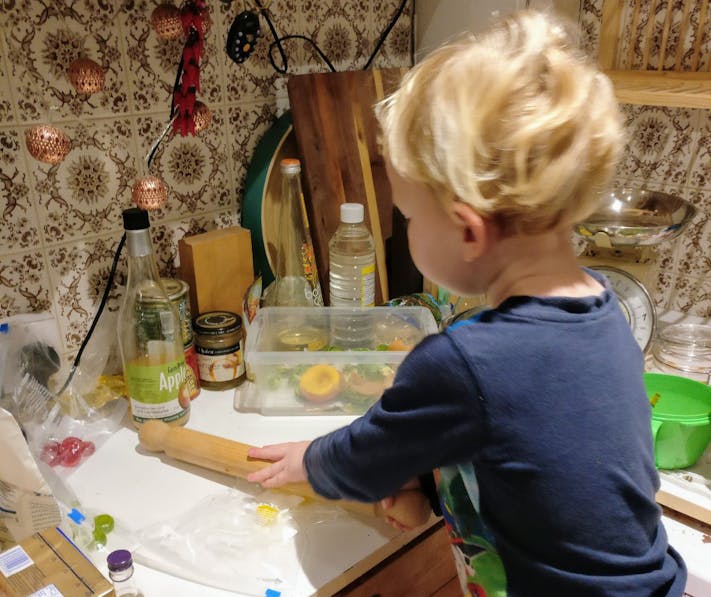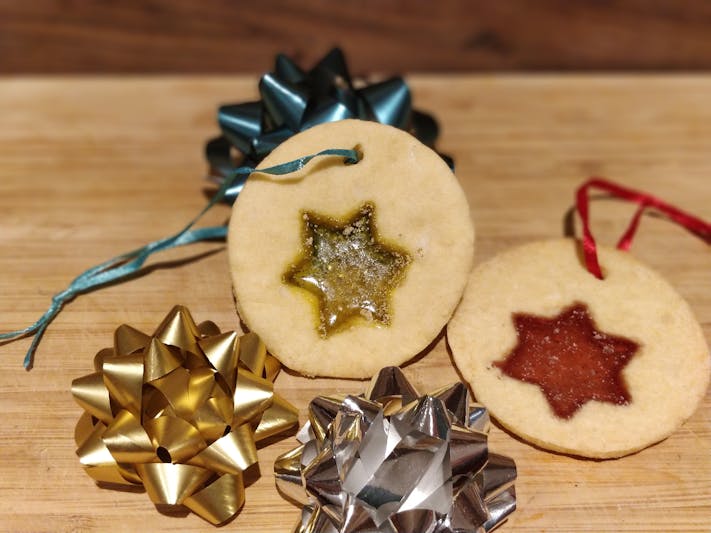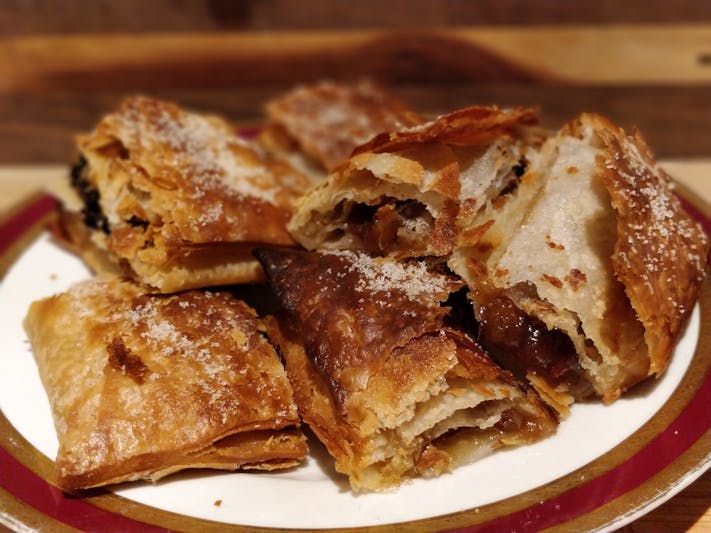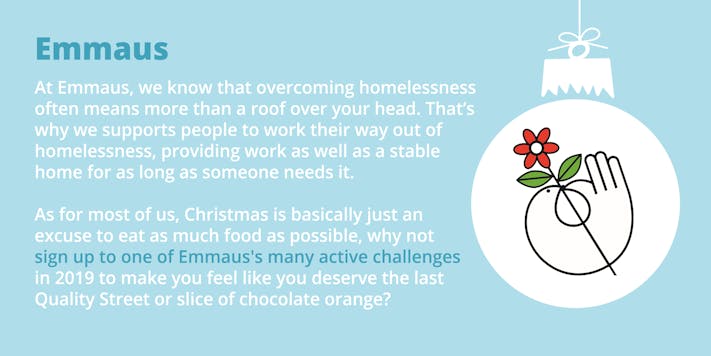Daily Info's Advent Calendar 2018
Today we offer two recipes that children might like to join in making, and one sort of cake that is specifically to give to children, historically to your Godchildren.

Stained Glass Window Biscuits
based on the recipe from Favourite Christmas Recipes published by JP Salmon
Salmon published postcards, and branched out into this series of postcard-sized books mainly as a way to use their extensive archive of illustrations! A lot of their books focus on regional cookery.
These biscuits are theatrical and fun, and you can involve different sizes of children easily, from bashing up the boiled sweets to cutting out the biscuits. The biscuit mix itself is simple but makes a lovely crisp result. Replacing some of the flour with chocolate might give a good colour contrast with the stained glass, as an alternative.
2oz/55g icing sugar
1 tbsp milk
6oz/170g flour (Doves Farm gluten-free plain flour works fine)
4oz/115g butter/margarine
1/2 tsp vanilla essence
boiled sweets, 4oz/115g would be plenty! Assorted colours are fun*.
*We used Sainsbury's Clear Fruits in red, dark red, green and yellow, which are dyed with natural colourings including curcumin (from turmeric) and spirulina.
To make the pastry combine all ingredients except the boiled sweets in a mixing bowl to make a pliable dough. Cover with cling film and refrigerate for 45 mins.
You can use this time to bash up the sweets. We found that sorting the sweets into different coloured piles, unwrapping them, putting them in freezer bags and bashing them with a rolling pin was all very child-friendly. They are pretty hard, and did dent the rolling pin, so be careful of fingers. They also had the potential to break into sharp enough bits to pierce the bag, and when we hadn't sealed the bag a sweet shot out across the room. I wouldn't let kids do this bit unsupervised!
Set the oven to 200C or gas 6.
Roll out the dough to 1/8 - 1/4 inch thick. You need two cutters - one large for the overall biscuit, and one smaller to cut out the stained glass bit. We used a drinking glass and a small star cutter. This gave the effect of baubles, sort of.
Transfer to your lined baking tray. We used a silicon liner, which meant the finished biscuits came off beautifully. If you're using baking parchment grease it well, or the melted sweets may stick!
Now make a hole near the top of the biscuit with a skewer, big enough to put your thread through the finished item. Now sprinkle your sweet shards into the gap. We overfilled ours, and they bubbled over a bit.
Bake for 10-12 minutes, until the biscuit is looking slightly coloured and the sweets have melted. Leave to cool before you try to transfer them, though this only takes 15-20 minutes. Gently unstick them by peeling away the baking parchment/liner.
When cool, thread ribbon or festive thread through the hole and hang on the tree!

Slime
Absolutely not for eating! But if you're going to make some of this up-to-the-moment plaything this is a good recipe for children, who may or may not learn some chemistry along the way.
250ml PVA glue (white or clear)
50ml water
Contact lens solution that contains Borax (Sodium borate)
1/tsp bicarbonate of soda
Food colouring or acrylic paint if you want to colour your slime
baby oil or coconut oil
Start with the glue in a big bowl. Add the water.
Add the bicarbonate of soda, and the colouring or paint if you are using them.
Now add contact lens solution, one generous squirt at a time, and mix after each squirt. This should thicken the glue up into slime.
When it's the right consistency, oil your hands, take it out of the bowl, and knead it. A paper plate is a good thing to knead it on, or you can use a plastic chopping board.
You could also go overboard and add glitter, or beads, especially if you're making this as a Christmas present for someone.
Have fun!
More Recipes
For endless variations on the basic slime recipe, you need a book, and there are several out there, including The Ultimate Slime Guide by Sarah McClelland and Magical Rainbow Slime published by Scholastic (whose author is too shy to be named). The latter even includes a recipe called Unicorn Poop. That's the zeitgeist, folks.

Warnings!
Even if you put deliciously edible flavourings in, SLIME IS NOT FOR EATING! There are safe recipes on the internet if your child is likely to put slime in their mouth, but honestly it's not a good habit to get into and won't stand them in good stead for school science lessons.
Never dispose of slime down the drain - it will block it (even if it is technically a liquid). When your slime gets a bit elderly and you want to get rid of it put it in the bin. It'll last longer if you keep it in the fridge when not in use.
Slime can stick to soft furnishings. If you are the person who's got a brand new sofa in time for Christmas consider banishing slime to the garden.
In case you are interested in the science behind Slime...
Chemistry - how the slime forms
The P in PVA glue or PVC plastic stands for Poly- meaning "many". Polymers like PVA glue consist of lots of repeating units stuck together in a long chain, like beads sticking together to make a necklace, or making a long chain out of paperclips.
An activator like Borax cross-links these long chains, changing the glue from a viscous (sticky) liquid where the strands slide past each other quite easily, to a linked network of strands where the chains are held together more rigidly.
Physics - why slime behaves like Slime
Even with the crosslinking, Slime is not a true solid - it's a non-Newtonian fluid. Probably the best known non-Newtonian fluid is custard, or a mix of cornflour and water. You can see videos on the internet of people standing in a bath of cornflour and water and sinking in, but being able to run across the surface without sinking. This is because non-Newtonian fluids can behave like solids if you apply a force.
You can tell that Slime is really a liquid not a solid, because it will eventually take the shape of whatever container you put it in.
This excellent pdf from the American Chemical Society's publication for students, ChemMatters, explains more.
God's Kitchels
Since kitchels are a present for your Godchildren, it would be neat if "kitchel" meant children, somehow derived from kinder, or kilder, but it seems more likely it means cake. Kitchels have a confusing history, with a lot of options and no definites. They seem to be a Suffolk tradition, when these cakes were baked between 21st and 31st December, a time when your godchildren were sure to visit. They would ask for a blessing, and get both a blessing and a cake! An early form of child bribing.
Kitchels have a traditional role in Harwich too, where the new Mayor throws them from the Guildhall in May when he or she is newly appointed, as a metaphor for the good he's going to spread in the city. It's a bit like the Abingdon bun-throwing ceremony. Some think the name was a corruption of "catch all".
And in Coventry, the very similar Godcakes are a New Year tradition, again for godchildren.
The first reference comes in Chaucer (who was good at firsts - there's an extraordinarily long list of words whose first documented source is somewhere in his works). The Summoner's Tale (one of the Canterbury Tales, of course) starts with a friar begging house to house for big or small donations, in the lines:
Yif us a busshel whete, malt, or reye / A Goddes kechyl, or a trype of chese
I don't know if Chaucer was particularly connected with Coventry, Suffolk or Harwich, but his job took him roaming around England and continental Europe, and in any case he may just mean "little cake" (as in German "kuche" or Yiddish "kikhl", or Anglo-Saxon "cicel", meaning morsel or circle...)
In contrast with its tortuous history, the recipe is dead simple! This version is from the lovely The Farmhouse Kitchen by Mary Norwak, a keen amateur cookery historian and writer, who lived in East Anglia. It is also delicious - these are a fabulous alternative to mince pies, easy to make and well worth reviving as a tradition.

450g / 1lb puff pastry
225g / 8oz currants
75g / 3oz candied peel
zest of one lemon
1 tsp cinnamon
1 tsp nutmeg
50g / 2oz ground almonds
50g / 2oz butter, melted
Heat the oven to 220C / gas 7.
Divide the pastry in two, and roll each out thinly into a square. These should of course be the same size as each other!
To make the filling, mix the currants, peel, spices and almonds and stir into the butter. Spread this filling evenly onto one square of pastry, to within 1/2 inch of the edge. Moisten the edges and press the second piece of pastry on top.
With the back of a knife (ie just scoring, not going through the pastry), mark out 2inch squares on top. Bake for 20-25 mins.
Sprinkle with caster sugar and divide into small cakes along your scoring lines, while still warm.
Variations:
Jus-rol now do a gluten-free puff pastry sheet, which is also dairy free. It weighs 280g so you need half the quantity of filling ingredients above. I would recommend using the pastry sheet lengthways and making two roughly square pockets of filling. This means during the cutting up each kitchel has two sealed sides and two open sides, making it easier to eat (though this is still plate food not easy buffet food as the filling does tend to leak out).
You may come across recipes to make this with commercial mincemeat, which is quicker, but very gooey and too sweet for my panel of tasters. We really recommend the original filling above, which takes no longer to put together than the oven does to heat up. And it makes you feel pleasingly medieval.
If you use ready-made puff pastry this recipe is so quick and straightforward it could easily be made by small godchildren. Though of course the dried fruit and spices would once have been expensive imports, and a rare treat!
Giving something back
If you're feeling extra-generous this season of goodwill, check out our charitable suggestion of the day:

Welcome to Daily Info’s 2024 Advent Calendar – 24 days of events to celebrate the festive period and get ready to ring in the New Year!
This year's calendar offers a mix of Christmas activities - pantos, comedy shows, carol concerts etc, taking in traditions in Oxford and the wider area, as well as free diversions in December and some of the best happenings to book ahead for in 2025.


Back to calendar









